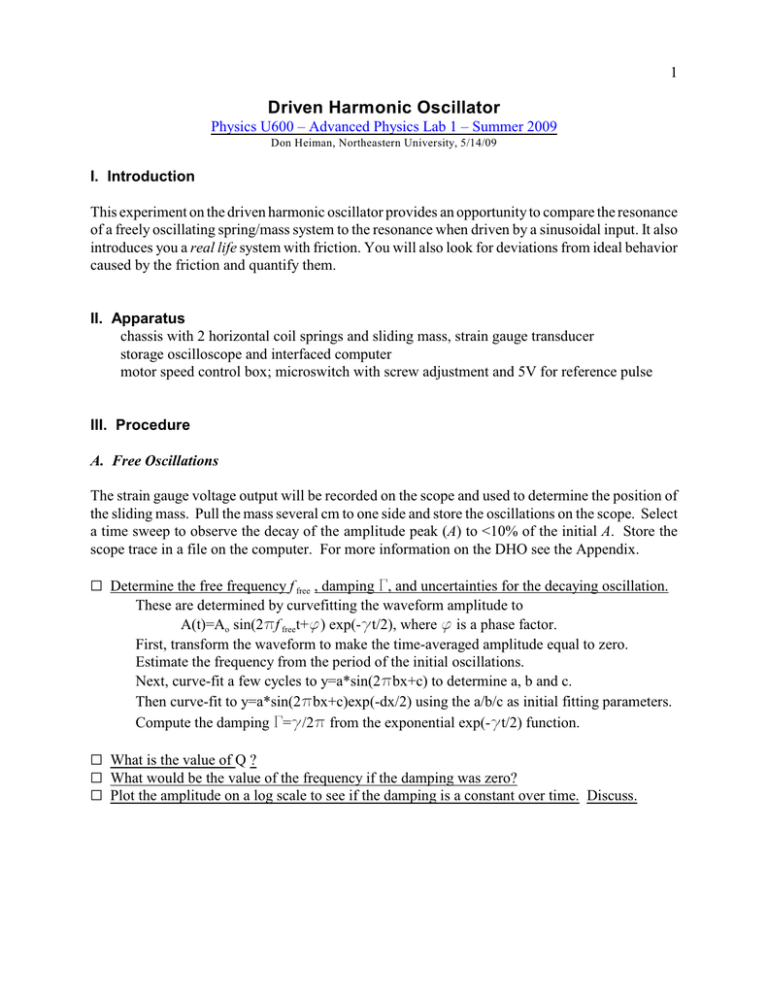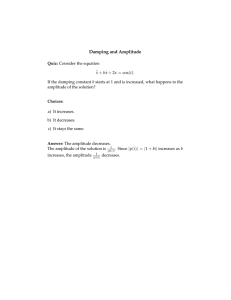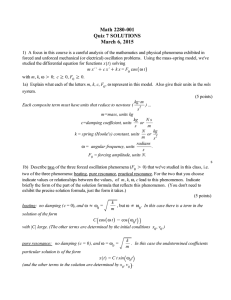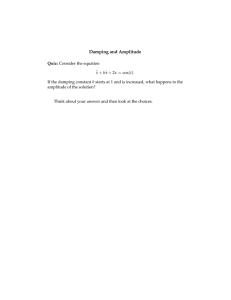Driven Harmonic Oscillator
advertisement

1
Driven Harmonic Oscillator
Physics U600 – Advanced Physics Lab 1 – Summer 2009
Don Heiman, Northeastern University, 5/14/09
I. Introduction
This experiment on the driven harmonic oscillator provides an opportunity to compare the resonance
of a freely oscillating spring/mass system to the resonance when driven by a sinusoidal input. It also
introduces you a real life system with friction. You will also look for deviations from ideal behavior
caused by the friction and quantify them.
II. Apparatus
chassis with 2 horizontal coil springs and sliding mass, strain gauge transducer
storage oscilloscope and interfaced computer
motor speed control box; microswitch with screw adjustment and 5V for reference pulse
III. Procedure
A. Free Oscillations
The strain gauge voltage output will be recorded on the scope and used to determine the position of
the sliding mass. Pull the mass several cm to one side and store the oscillations on the scope. Select
a time sweep to observe the decay of the amplitude peak (A) to <10% of the initial A. Store the
scope trace in a file on the computer. For more information on the DHO see the Appendix.
G Determine the free frequency f free , damping G, and uncertainties for the decaying oscillation.
These are determined by curvefitting the waveform amplitude to
A(t)=Ao sin(2pf freet+f) exp(-gt/2), where f is a phase factor.
First, transform the waveform to make the time-averaged amplitude equal to zero.
Estimate the frequency from the period of the initial oscillations.
Next, curve-fit a few cycles to y=a*sin(2pbx+c) to determine a, b and c.
Then curve-fit to y=a*sin(2pbx+c)exp(-dx/2) using the a/b/c as initial fitting parameters.
Compute the damping G=g/2p from the exponential exp(-gt/2) function.
G What is the value of Q ?
G What would be the value of the frequency if the damping was zero?
G Plot the amplitude on a log scale to see if the damping is a constant over time. Discuss.
2
B. Off-Resonance Driven Oscillations
Here you will drive the system near the resonance frequency fo with the variable-speed motor at
frequency f and examine the amplitude in the two off-resonance regions defined by | fo-f |>>G.
Input the amplitude signal into channel-1. At low amplitudes the voltage is quite noisy, so you can
use the averaging function of the scope to greatly reduce the noise level, or use a low-noise
preamplifier to increase the voltage amplitude by 10-20x. Make sure to measure the amplitude A as
determined from the vertical centers of the noisy traces, not the highest and lowest values of the
noise.
In channel-2, input the voltage pulse from the microswitch and 5V source in series. Adjust the
motor control to the lowest speed where the amplitude A on the scope is still measurable. Measure
the frequency on channel-2 using the “measure” mode and “Normal” setting for the scope triggering
on channel-2.
G Record data of A versus f, beginning at low f and increase f until A becomes large.
G Continue to record data until A becomes too small to measure.
G Discuss how you account for the voltage noise in the measurement of A.
G
G
G
G
G
Transform the x-axis to f 2 and the y-axis to 1/A.
For both sections, f < fo and f > fo, curve fit 1/A versus f 2 to a linear function.
How linear is the A-1(f 2) dependence in the off-resonance regions?
Plot both data sets on one graph.
Discuss where the two linear curves intersect.
C. Near-Resonance Region
Finely adjust the motor frequency near f o to achieve the maximum amplitude (Am) of the sliding
mass. Quantify this resonance region by measuring A on the scope while changing f in small steps
of )f=0.01 Hz. Do this on both sides of Am to obtain data down to about Am/5 on both sides of the
resonance.
G
G
G
G
Plot A versus f -- as you take the data.
Curve fit A(f) to the expected resonance formula to obtain fo and G, and their uncertainties.
In a table, compare the frequency, damping, and Q to those measured in the previous sections.
Discuss these values in your report.
G Visually, compare the sign of the phase angle on either side of the resonance (are the sliding
mass and the driver going in the same or opposite directions)? Discuss.
3
IV. Appendix: Notes on Driven Damped Harmonic Oscillator
This page derives formulas for mechanical and electrical harmonic oscillators which have damping.
The next page derives formulas for a harmonic oscillator (HO) that is driven externally.
Mechanical HO
LRC Electrical HO
The damped force equation
for the position x(t) is
The voltage equation for
capacitor charge q(t) is
Here, m is the mass, b the velocity-dependent
damping constant, and k the spring constant.
Using the following substitutions
Here L is the inductance, R is the resistance, C is
the capacitance, and i=dq/dt is the current. Using
the following substitutions
g = b/m
and
w02 = k/m.
_____________________________________
g= R/L
and
w02 = 1/LC.
_____________________________________
These equations can be rewritten generally as
Solutions are found by substituting
x(t)=Re{Ae a t} into the differential equation,
then
[a2+ag+ w02] x(t) = 0, or [a2+ag+w02] = 0, and a = ½ [–g ± (g 2–4 w02)1/2].
The solution for the underdamped case, g<<w0, is a
sinusoid with a decaying amplitude given by
The damping constant g has the same units of frequency as the oscillating frequency w0. The angular
frequency w has units of radians/sec, or simply s–1. The frequency f has units of Hertz (cycles/sec),
where w=2 p f,. The period of oscillation, T, is T = 1/f = 2 p/w.
Note that the damping reduces the frequency from w0 to w’ = (w02 – g2/4)1/2 = w0(1 – g2/4w02)1/2.
The “quality factor” or Q-factor is a dimensionless quantity given by the ratio of frequency to damping,
4
Driven Harmonic Oscillator
Adding a sinusoidal driving force at frequency w to the mechanical damped HO gives
The solution is now
x(t) = A(w) sin [wt – d(w)].
The amplitude A and phase d as a function of the driving frequency are
and
Note that the phase has the opposite sign for w < w0 and w > w0 conditions.
The maximum amplitude A max occurs at the driving frequency w0 given by
The maximum amplitude is proportional to 1/g – the smaller the damping the larger the maximum
amplitude.
The graph shows a plot of A(w). Note that the fullwidth at half-maximum of the amplitude is not equal
to g.
For small damping (g<<w0),





